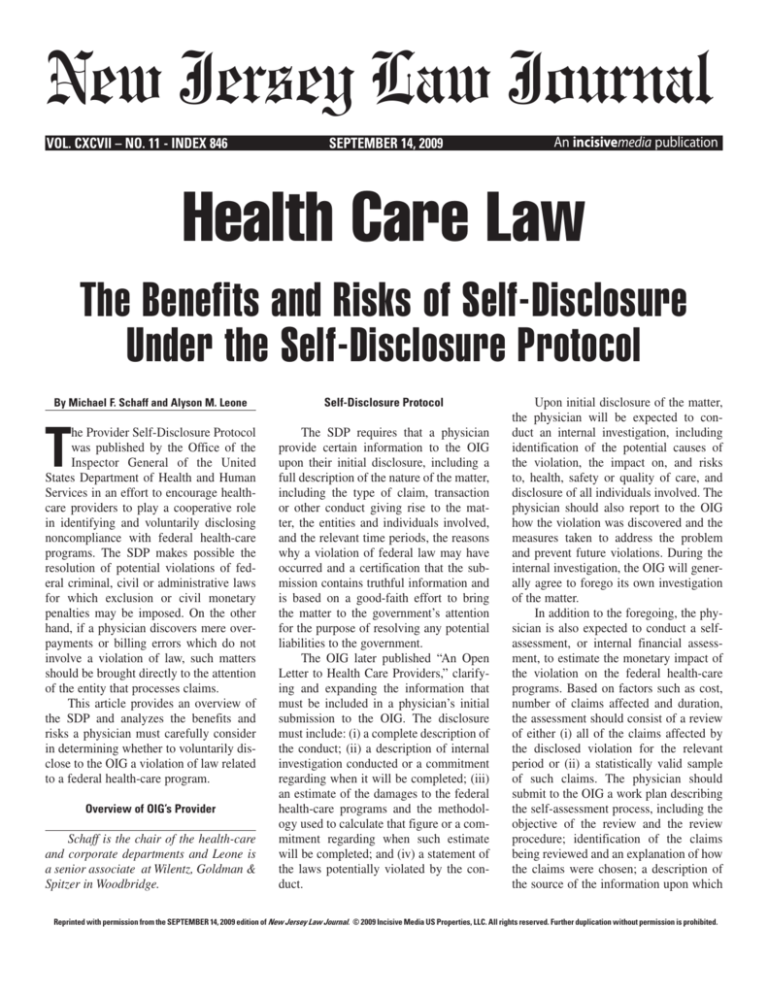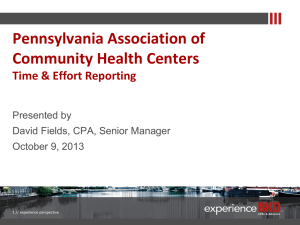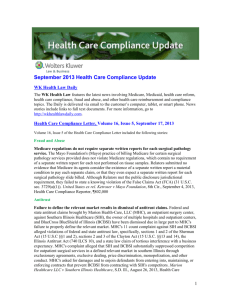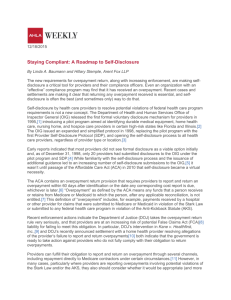
New Jersey Law Journal
VOL. CXCVII – NO. 11 - INDEX 846
SEPTEMBER 14, 2009
An incisivemedia publication
Health Care Law
The Benefits and Risks of Self-Disclosure
Under the Self-Disclosure Protocol
By Michael F. Schaff and Alyson M. Leone
T
he Provider Self-Disclosure Protocol
was published by the Office of the
Inspector General of the United
States Department of Health and Human
Services in an effort to encourage healthcare providers to play a cooperative role
in identifying and voluntarily disclosing
noncompliance with federal health-care
programs. The SDP makes possible the
resolution of potential violations of federal criminal, civil or administrative laws
for which exclusion or civil monetary
penalties may be imposed. On the other
hand, if a physician discovers mere overpayments or billing errors which do not
involve a violation of law, such matters
should be brought directly to the attention
of the entity that processes claims.
This article provides an overview of
the SDP and analyzes the benefits and
risks a physician must carefully consider
in determining whether to voluntarily disclose to the OIG a violation of law related
to a federal health-care program.
Overview of OIG’s Provider
Schaff is the chair of the health-care
and corporate departments and Leone is
a senior associate at Wilentz, Goldman &
Spitzer in Woodbridge.
Self-Disclosure Protocol
The SDP requires that a physician
provide certain information to the OIG
upon their initial disclosure, including a
full description of the nature of the matter,
including the type of claim, transaction
or other conduct giving rise to the matter, the entities and individuals involved,
and the relevant time periods, the reasons
why a violation of federal law may have
occurred and a certification that the submission contains truthful information and
is based on a good-faith effort to bring
the matter to the government’s attention
for the purpose of resolving any potential
liabilities to the government.
The OIG later published “An Open
Letter to Health Care Providers,” clarifying and expanding the information that
must be included in a physician’s initial
submission to the OIG. The disclosure
must include: (i) a complete description of
the conduct; (ii) a description of internal
investigation conducted or a commitment
regarding when it will be completed; (iii)
an estimate of the damages to the federal
health-care programs and the methodology used to calculate that figure or a commitment regarding when such estimate
will be completed; and (iv) a statement of
the laws potentially violated by the conduct.
Upon initial disclosure of the matter,
the physician will be expected to conduct an internal investigation, including
identification of the potential causes of
the violation, the impact on, and risks
to, health, safety or quality of care, and
disclosure of all individuals involved. The
physician should also report to the OIG
how the violation was discovered and the
measures taken to address the problem
and prevent future violations. During the
internal investigation, the OIG will generally agree to forego its own investigation
of the matter.
In addition to the foregoing, the physician is also expected to conduct a selfassessment, or internal financial assessment, to estimate the monetary impact of
the violation on the federal health-care
programs. Based on factors such as cost,
number of claims affected and duration,
the assessment should consist of a review
of either (i) all of the claims affected by
the disclosed violation for the relevant
period or (ii) a statistically valid sample
of such claims. The physician should
submit to the OIG a work plan describing
the self-assessment process, including the
objective of the review and the review
procedure; identification of the claims
being reviewed and an explanation of how
the claims were chosen; a description of
the source of the information upon which
Reprinted with permission from the SEPTEMBER 14, 2009 edition of New Jersey Law Journal. © 2009 Incisive Media US Properties, LLC. All rights reserved. Further duplication without permission is prohibited.
2
NEW JERSEY LAW JOURNAL, SEPTEMBER 14, 2009
the review will be based; and identification
of the names and titles of the individuals
conducting the self-assessment.
The internal investigation and selfassessment must be completed within three
months. Once the reports are produced
to the OIG, the OIG will begin to verify
the information disclosed. The OIG will
require access to all work papers and supporting documents.
In 2006, in “An Open Letter to Health
Care Providers,” the OIG announced an
initiative to encourage the use of the SDP
to resolve civil monetary penalty liability under the self-referral (Stark) law and
antikickback statute for financial arrangements between hospitals and physicians, in
particular, situations involving a financial
benefit knowingly conferred by a hospital
upon physicians. The OIG announced that
for self-referral violations, the calculation
of civil monetary penalties would be based
on the number and dollar value of improper
claims. For kickbacks, the penalties calculation would be based on the number
and dollar value of improper payments or
remuneration.
Recent Changes to SDP
On March 24, the OIG, in “An Open
Letter to Health Care Providers,” narrowed
the scope of the SDP by announcing that
they would no longer accept disclosure of
matters that involve only liability under
the self-referral (Stark) law, in the absence
of an antikickback statute violation. The
OIG’s focus would be on kickbacks intended to induce or reward a physician’s referrals. In addition, the OIG established a
minimum settlement amount. For kickback
self-disclosures under the SDP, the OIG
will require a minimum $50,000 settlement
amount to resolve the matter.
Benefits of Self-Disclosure
If a physician discovers a violation of
law in their practice relating to a federal
health care program, the physician should
consider whether voluntarily disclosing the
violation under the SDP would be beneficial to the physician and their practice. The
following are some of the benefits to selfdisclosure under the SDP.
197 N.J.L.J.846
In general, the intent of the OIG in
promulgating the SDP is to encourage
physicians to conduct self-evaluations of
their compliance with federal health care
program requirements and to self-disclose
violations. Therefore, the OIG may be
more willing to reduce penalties for physicians who cooperate in identifying and
voluntarily disclosing violations.
One of the main benefits to selfdisclosure is that if the physician has an
effective compliance program and demonstrates trustworthiness, the OIG will waive
its authority to exclude the physician from
federal health-care programs, which could
result in a slow death to a physician’s
practice. The OIG has stated that detection
and prompt disclosure of potential fraud
are evidence of an effective compliance
program. Moreover, the OIG will consider
such compliance measures as a mitigating
factor in determining a resolution to the
violation, and will not generally require
the physician to enter into a Corporate
Integrity Agreement or Certification of
Compliance Agreement.
Another benefit to self-disclosure
under the SDP is that the OIG has stated
that it will generally settle SDP matters
for an amount near the lower end of the
continuum for calculating civil monetary
penalty damages.
Finally, by self-disclosing, physicians
may be able to avoid costly and protracted government investigations that would
likely be disruptive to their practice. In
addition, it gives physicians the ability to
disclose what happened in the best possible
light, which may result in a more favorable
settlement for the physician.
enure to the disclosing entity.” Further, the
OIG “is not obligated to resolve the matter
in any particular manner.” Therefore, there
is no guarantee that by self-disclosing the
violation, the physician will be given any
leniency in resolving the matter.
Disclosure of a potential violation
to the OIG does not shield the physician
from additional claims and penalties from
other governmental agencies. The OIG,
after reviewing the disclosure, may determine that the matter should be referred to
the United States Department of Justice
(“DOJ”) for consideration under its civil
and/or criminal authorities. The OIG’s
agreement to resolve a matter disclosed
under the SDP is not binding on the DOJ.
Further, the physician must agree in writing that settlement of the matter does not
affect the government’s ability to pursue
criminal, civil or administrative remedies
or to obtain additional fines, damages or
penalties for the violation.
Similarly, additional violations uncovered by the OIG during its review of the
physician’s disclosure, which are outside
the scope of the matter disclosed to the
OIG, may be treated as new matters outside
the SDP. In other words, the OIG may discover additional violations for which they
can hold the physician liable.
Finally, under the most recent changes
to the SDP, once a violation is submitted
to the OIG under the SDP, the minimum
settlement amount is $50,000. Physicians
must carefully consider the minimum settlement amount in light of the nature and
extent of the violations being disclosed.
Risks of Self-Disclosure
The most important lesson for physicians from the OIG guidance on selfdisclosure is that they should implement an
effective compliance plan designed to educate their office staff and set out a procedure for early discovery of non-compliance
with federal health-care plan requirements
and the steps to determine how to address
such violations. It is imperative that physicians consult with their health-care counsel
as soon as a violation is discovered so that
the benefits and risks of self-disclosure
can be assessed and disclosure made in a
timely manner, if appropriate. ■
Although the OIG encourages voluntary self-disclosure and there are certain
benefits, as discussed above, to participating in the SDP, a physician’s decision to
self-disclose a violation of federal criminal, civil or administrative laws relating to
federal health-care programs is not without
risk.
The OIG has specifically stated that
it “cannot reasonably make firm commitments as to how a particular disclosure will
be resolved or the specific benefit that will
Conclusion







